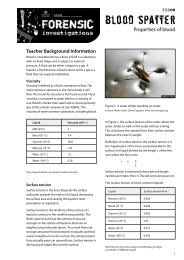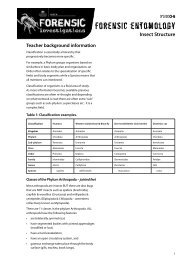FSE 10 Teachers activity [PDF File, 3.0 MB] - Centre for Learning ...
FSE 10 Teachers activity [PDF File, 3.0 MB] - Centre for Learning ...
FSE 10 Teachers activity [PDF File, 3.0 MB] - Centre for Learning ...
Create successful ePaper yourself
Turn your PDF publications into a flip-book with our unique Google optimized e-Paper software.
<strong>FSE</strong><strong>10</strong><strong>for</strong>ensic entomology<strong>Teachers</strong>: Activity In<strong>for</strong>mationChrysomya rufifacies – a secondary strike blow flywhatis known!Larvae (3 rd instar) collected from the crime scene.d. egg hatch → pre-pupation = 294 ADHe. pupation → adult emergence = 3696 ADHf. totaL ADH <strong>for</strong> development = 5082 ADH (15.1 daysat 24 o C)Calculate the date <strong>for</strong> pupationThe collected larvae pupated and emerged as adultsafter 13.5 days in the lab on the 24 th November 2006.The larvae pupated on the 12 th November.ADH <strong>for</strong> 11.5 days in lab conditions = 11.5 days x 336ADH/day in lab= 3864 ADHCalculate the date <strong>for</strong> egg depositionThe larvae pupated on 12 th November.The ADH required <strong>for</strong> the development from egg tolate 3 rd instar is 1386 ADH.Based on the ADH calculations in Table 6, the ADHfrom the 7 th November through to the 12 th Novemberis 1365 – sufficient <strong>for</strong> development.Based on the above calculations, eggs that arecollected as larvae on the corpse were laid on the 7 thNovember.Do the results from 2 different species support theestimated PMI of the 3 rd November?Lucilia sericata is a primary strike blow fly that willoviposit within 4 hours of a person dying. Theestimated date is the 3rd November – probablysometime during the day as blow flies are not active atnight. This fly is also generally found in urban habitats.Chrysomya rufifacies is a secondary strike blow flythat will oviposit within 4 days of a person dying. Theestimated time <strong>for</strong> egg deposition is the 7 th November.Chrysomya rufifacies is a fly that is found in both ruraland urban habitats.The murder zone is in a different location to the“dumping zone”. The murder zone would be in anurban setting while the crime scene is in the countryeast of Perth. The murderer would have shiftedthe location of the corpse sometime after the 3 rdNovember and the discovery of the body on the 11 thNovember.STUDENT QUESTIONS1. What day in November did Mr X die?2. What is your supporting evidence?3. Lucilia sericata was NOT one of the speciesthat was net caught over the corpse on the11 th November? Yet, collected pupa weresubsequently found to be Lucilia sericata.Chrysomya rufifacies were net caught at the crimesite AND were identified as the larvae that werefound on the corpse. How do you account <strong>for</strong>this?4. How accurate do you think your calculations are?5. What are the limitations of this method <strong>for</strong>estimating PMI?6. What extra data would you need to provide amore accurate and precise PMI?7. Two species of blow fly were involved indetermining PMI <strong>for</strong> the crime: Lucilia sericataand Chrysomya rufifacies. Why would the <strong>for</strong>ensicentomologist calculate in<strong>for</strong>mation <strong>for</strong> bothspecies of fly rather than just one type of fly?8. Dr Dadour noted that the corpse was found in adamp and shady location. Would this in<strong>for</strong>mationhave any bearing on his calculations <strong>for</strong> PMI?Activity 11 – What happened?• Students share reconstructions and re-enactingwhat they think happened – when did the victimdie?• Students present their evidence.21


![FSE 10 Teachers activity [PDF File, 3.0 MB] - Centre for Learning ...](https://img.yumpu.com/45506425/21/500x640/fse-10-teachers-activity-pdf-file-30-mb-centre-for-learning-.jpg)
![FSP 19 Anthropometry [PDF File, 298.3 KB]](https://img.yumpu.com/51210323/1/184x260/fsp-19-anthropometry-pdf-file-2983-kb.jpg?quality=85)


![FSE 09 Case studies [PDF File, 140.2 KB] - Centre for Learning ...](https://img.yumpu.com/48750159/1/184x260/fse-09-case-studies-pdf-file-1402-kb-centre-for-learning-.jpg?quality=85)
![FSE 03 [PDF File, 125.2 KB] - The University of Western Australia](https://img.yumpu.com/47991868/1/184x260/fse-03-pdf-file-1252-kb-the-university-of-western-australia.jpg?quality=85)
![FSE 01 Overview [PDF File, 163.0 KB]](https://img.yumpu.com/47583056/1/184x260/fse-01-overview-pdf-file-1630-kb.jpg?quality=85)

![Chapter 03 [PDF File, 468.5 KB] - Centre for Learning Technology](https://img.yumpu.com/44881443/1/184x260/chapter-03-pdf-file-4685-kb-centre-for-learning-technology.jpg?quality=85)
![Chapter 09 5 [PDF File, 192.4 KB]](https://img.yumpu.com/44599682/1/184x260/chapter-09-5-pdf-file-1924-kb.jpg?quality=85)
![FSB 03 [PDF File, 151.9 KB]](https://img.yumpu.com/43260078/1/184x260/fsb-03-pdf-file-1519-kb.jpg?quality=85)

![FSE 11 Rearing flies [PDF File, 388.4 KB]](https://img.yumpu.com/41885287/1/184x260/fse-11-rearing-flies-pdf-file-3884-kb.jpg?quality=85)
![FSP 26 Crime Dossier [PDF File, 3.2 MB]](https://img.yumpu.com/36466452/1/184x260/fsp-26-crime-dossier-pdf-file-32-mb.jpg?quality=85)
![FSE 07 Forensic entomology [PDF File, 196.9 KB]](https://img.yumpu.com/35416705/1/184x260/fse-07-forensic-entomology-pdf-file-1969-kb.jpg?quality=85)